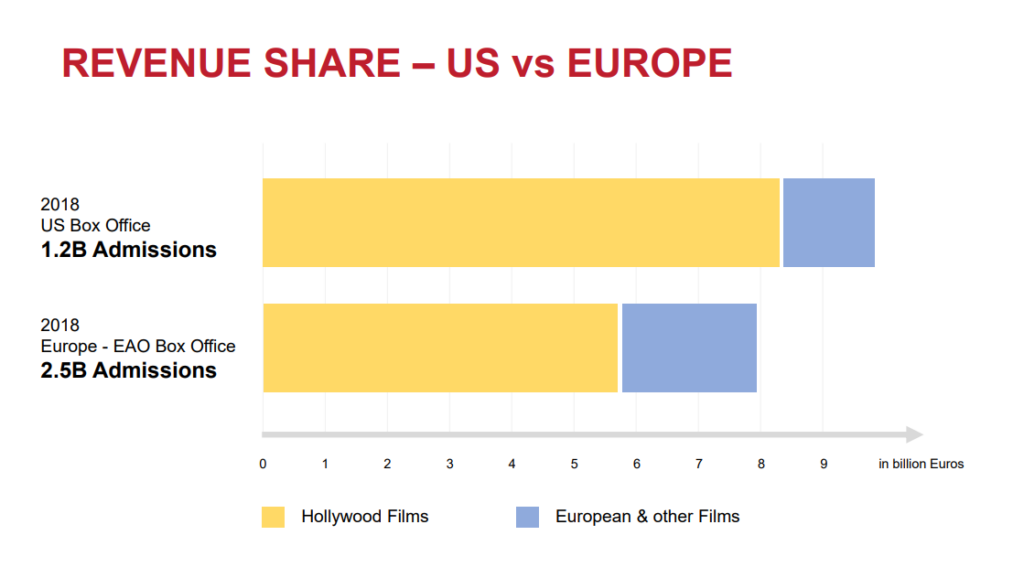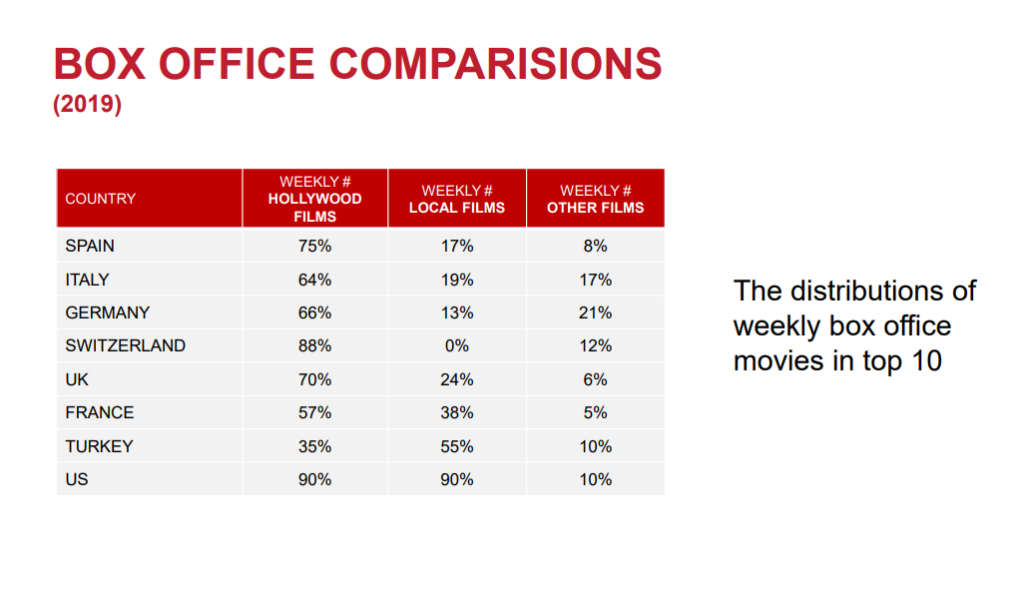Take a look at the graph below which shows the figures behind Hollywood’s dominance of the European box office.

How can it be that European films are so overshadowed by both at home and abroad by U.S movies? Could it be that European films are just not that good? Perhaps they just don’t have the same appeal to mass audiences? And why is it that European films only perform slightly better with their own European audiences than they do in the United States?
Given that European filmmakers should understand their home audience better, what is going so wrong that Hollywood movies commanded a staggering 80% of ticket sales in 2018? It is certain that understanding the answer to this question is the key to European films winning back their audiences.
What is Going Wrong?
In July 2020, Sami Arpa, CEO of AI-assisted Moviemaking company Largo.ai, took part in a NEXT 2020 video conference in which he detailed the scale of the problem facing European films. He began by highlighting the following statistics:

What immediately jumps out is that U.S production spending averages 4.4 million Euros vs. 1.3 million Euros for each European film.
Naturally, this data implies that, on average, European filmmakers have around 3.5 times less money to spend on their productions, something which would hit the more marketable elements of mainstream movies hard. These include special effects, big-name stars, etc.
For these examples, the formula is simple – lots of large explosions and special effects plus big name stars more than likely equals a big box office draw.
However, the real reasons behind this phenomenon is far more complex as it involves everything from the type and quality of individual films that are being offered, the means and availability of distribution, marketing, and a range of other factors.
So, once again, we find ourselves asking, what is going wrong for European films?
Well, the truth is that this is a question that the European film business has been trying to answer for decades. Fortunately, the emerging technology of AI-assisted moviemaking might just, at long last, be able to provide us with an answer.
Understand European Audiences
In his presentation, Sami Arpa highlights an important, and indeed, critical distinction between European and U.S audiences by breaking down the problem by individual country. Europe comprises of 44 countries, each with its own culture and almost all with its own language (or several).
Turkey, for example, has 23 (native) languages spoken within its borders, while the British Isles has 4 widely used languages and a total of 10 other regional languages. This makes Europe a more complex market than the U.S as the diversity of socio/cultural differences is as equally rich and diverse as the languages.
While this is a dream for travelers, it represents a real challenge for filmmakers.
The following table breaks down Arpa’s figures relating to saturation by U.S films in each of Europe’s biggest film markets (countries).

These figures provide an excellent insight into the diversity of the problem across Europe. Why, for example, is the saturation by U.S films in Turkey far lower than it is in Spain? Well, while the Turkish government has recently enacted a (2019) controversial law to protect ‘traditional values’, which many U.S films would not meet, this would not account for such low numbers.
Turkey does have a healthy film industry, which produced 172 films in 2018, however, this is also true of Spain which produced over 100 films in 2019, many of which were international commercial and critical successes.
This one example is repeated across the entire European area and gives a clear picture of how complex the European market is for filmmakers and distributors. However, once again, it raises more questions than it answers, specifically, how are U.S films still performing so well in most European markets when compared to their native counterparts?
Could it be that U.S movies are simply more fundamentally appealing on some elementary level of human appreciation? Do Europeans all somehow relate to wealthy, masked U.S superheroes than they do their own kin?
As you can see, trying to understand the why behind such a complex and different range of cultures, production values, business practices, governmental control, audience preferences, and everything else that is behind the films we choose to watch is a job far too complex for any one human to solve (superhero or not).
What is clear is that we need help in the form of a superhero that never sleeps, can trawl through endless pools of data without ever getting tired, and only gets smarter the more it works.
This superhero is, of course, artificial intelligence.
AI to the Rescue
AI-assisted filmmaking solutions, with sufficient development and access to enough data, have the power to allow European filmmakers and distributors to understand their audiences much better. As we have spent time pointing out, the distinction between ‘audiences’ rather than audience is the first step in achieving this understanding.
With sufficient data, AI systems will be able to extrapolate patterns or insights for groups down to the smallest regions. Provided that the data sources include data ranging from historic movie grosses for different types of films, number of movie theatres they played in, etc., and factors including movies they were in competition with, government regulations (censorship factors), and language variations, etc., AI systems will eventually be able to extrapolate what the markets are for specific types of films all over Europe.
Such data would be enormously powerful for producers who would then be able to see exactly why films have been successful and where their own films will likely succeed. The most obvious benefit of this would be that it would help European films compete with their larger budget U.S rivals and provide a huge financial boost to local industries. This enlarged investment pool for European films could then be reinvested into films to give them bigger budgets and therefore make them even more competitive.
As Arpa concludes, “We see the opportunity of AI here in two places. Firstly, AI can help European producers to better understand European audiences and to greenlight the projects that they want to see, and secondly, by using artificial intelligence, there might be more opportunity to enlarge the investment pool for European films because it will help to reduce the risks of the film and therefore help investors make important decisions based on actual data.”
Thus, AI’s ability to provide an in-depth understanding of all types and subtypes of European audiences is key to finally overturning the U.S dominance of European filmmakers.
Take a look at the graph below which shows the figures behind Hollywood’s dominance of the European box office.




